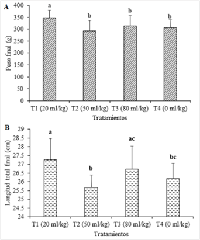Influence of a commercial probiotic on the growth and body composition of the sábalo Brycon amazonicus (Characiformes: Bryconidae)
DOI:
https://doi.org/10.56926/repia.v2i1.30Keywords:
feeding, diet, pisciculture, supplementsAbstract
The influence of the dietary improvement of the commercial probiotic EM® SHRIMP on the feeding of juvenile shad Brycon amazonicus reared in pens at a density of 1.1 fish/m3 was evaluated. A total of 120 fishes of 8.20 ± 0.73 cm and 5.74 ± 1.50 g of length and initial weight, respectively, were divided into 12 pens and went through an adaptation period of 10 days. Then, each group was fed a randomly oriented diet for 120 days. The diets were: T0 (control) without probiotic, T1 with 20 ml/kg of probiotic, T2 with 50 ml/kg of probiotic and T3 with 80 ml/kg of probiotic. It was found that the group fed on T1 obtained a greater growth in weight and final length compared to the other treatments. However, the probiotic preparation did not significantly affect the fat, carbohydrate, and protein content of the fish. In conclusion, the improvement of probiotics up to the level of 20 ml/kg improved the growth in size and weight of B. amazonicus. The body content of the fish did not vary significantly between the treatments, except in certain cases where higher concentrations of lipids, carbohydrates and proteins were observed.
Downloads
References
Álvarez, P., Soldi Soldi, H. D., Castro, M., & Del Valle Ayala, O. (2017). Protocolo de reproducción del sábalo cola roja (Brycon amazonicus). Fondepes, 1–36. https://www.gob.pe/institucion/fondepes/informes-publicaciones/2454181-protocolo-de-reproduccion-del-sabalo-cola-roja
Arias, J. A., Zaniboni-Filho, E., Pardo-Carrasco, S. C., & Vásquez-Torres, W. (2017). Ovogénesis del Yamú Brycon siebenthalae (Teleostei: Characidae), en cautiverio. Actualidades Biológicas, 26(81), 117–183. https://doi.org/10.17533/udea.acbi.329446
De Barros, I. B. A., Villacorta-Correa, M. A., & Carvalho, T. B. (2019). Stocking density and water temperature as modulators of aggressiveness, survival and zootechnical performance in matrinxã larvae, Brycon amazonicus. Aquaculture, 502, 378–383. https://doi.org/10.1016/j.aquaculture.2018.12.070
Dias, D. de C., Tachibana, L., Iwashita, M. K. P., Nakandakare, I. B., Romagosa, E., Seriani, R., & Ranzani-Paiva, M. J. T. (2020). Probiotic supplementation causes hematological changes and improves non-specific immunity in Brycon amazonicus. Acta Scientiarum. Biological Sciences, 42, e52473. https://doi.org/10.4025/actascibiolsci.v42i1.52473
García de la Banda García, I. (2011). Efecto de la adición de dos probióticos (Shewanella putrefaciens y Shewanella baltica) en el engorde del lenguado senegalés (Solea senegalensis Kaup, 1858) [Universidad de León]. https://doi.org/10.18002/10612/2346
Gatesoupe, F.-J. (2008). Updating the Importance of Lactic Acid Bacteria in Fish Farming: Natural Occurrence and Probiotic Treatments. Microbial Physiology, 14(1–3), 107–114. https://doi.org/10.1159/000106089
Gómez, A. E., Pinta, A. X., Pecillo, E. S., Ceron, S. M., & Delgado, J. E. (2013). Evaluación de dos tipos de zooplancton (artemia sp y copépodos) en la primera alimentación de sábalo (brycon melanopterus). Revista Investigación Pecuaria, 2(1). https://revistas.udenar.edu.co/index.php/revip/article/view/423
Hualinga Vásquez, K. K. (2013). Efecto del probiótico EM® agua en el crecimiento y composición corporal de alevinos de Piaractus brachypomus “paco” (Cuvier, 1818) (Pisces, Serrasalmidae), cultivados en corrales, CICMCR-IIAP-Bello Horizonte, San Martín [Universidad de la Amazonía Peruana]. http://repositorio.unapiquitos.edu.pe/handle/20.500.12737/3468
IIAP. (2016). Memoria Institucional 2015. Instituto de Investigaciones de la Amazonía Peruana. http://www.iiap.gob.pe/wfr_Descarga.aspx?id=m6IRotoi0ni8oxHJgvl25g==&tipo=SNrz4CY7n79ZfATctl9apg==
Muchlisin, Z. A., Murda, T., Yulvizar, C., Dewiyanti, I., Fadli, N., Afrido, F., Siti-Azizah, M. N., & Muhammadar, A. A. (2017). Growth performance and feed utilization of keureling fish Tor tambra (Cyprinidae) fed formulated diet supplemented with enhanced probiotic. National Center for Biotechnology Information, 6, 137. https://doi.org/10.12688/f1000research.10693.1
Nathanailides, C., Kolygas, M., Choremi, K., Mavraganis, T., Gouva, E., Vidalis, K., & Athanassopoulou, F. (2021). Probiotics Have the Potential to Significantly Mitigate the Environmental Impact of Freshwater Fish Farms. Fishes, 6(4), 76. https://doi.org/10.3390/fishes6040076
Nuñez, J. (2009). Domestication de nouvelles espèces d’intérêt piscicole en Amazonie. Agriculture, 18(2), 136–143. https://doi.org/10.1684/agr.2009.0299
Quesquén Fernández, R. O., Cho, J., Valdivia Zuta, J., García Flores, S., Cabrera Simón, A. E., & Samaniego Pipo, L. S. (2022). Estado actual da aquacultura na selva peruana: caso de Loreto / Current status of aquaculture in the Peruvian jungle: the case of Loreto. Brazilian Journal of Animal and Environmental Research, 5(2), 2383–2401. https://doi.org/10.34188/bjaerv5n2-078
Ramos, M. A., Batista, S., Pires, M. A., Silva, A. P., Pereira, L. F., Saavedra, M. J., Ozório, R. O. A., & Rema, P. (2017). Dietary probiotic supplementation improves growth and the intestinal morphology of Nile tilapia. Animal, 11(8), 1259–1269. https://doi.org/10.1017/S1751731116002792
Ríos Enrique, I. (2021). Calidad de agua en el cultivo de organismos acuáticos amazónicos (1st ed.). Editorial Barreto S.A.C.
Rohani, M. F., Islam, S. M., Hossain, M. K., Ferdous, Z., Siddik, M. A., Nuruzzaman, M., Padeniya, U., Brown, C., & Shahjahan, M. (2022). Probiotics, prebiotics and synbiotics improved the functionality of aquafeed: Upgrading growth, reproduction, immunity and disease resistance in fish. Fish & Shellfish Immunology, 120, 569–589. https://doi.org/10.1016/j.fsi.2021.12.037
Satalaya Arellano, H. (2013). Efecto del probiótico EM (microorganismos eficientes) sobre el crecimiento de alevinos de paco, Piaractus brachypomus (Cuvier, 1818) confinados en jaulas durante la segunda fase de alevinaje en Padre Abad-Perú [Universidad Nacional de la Amazonia Peruana]. http://repositorio.unapiquitos.edu.pe/handle/20.500.12737/2426
Sun, L., & Chen, H. (2014). Effects of water temperature and fish size on growth and bioenergetics of cobia (Rachycentron canadum). Aquaculture, 426–427, 172–180. https://doi.org/10.1016/j.aquaculture.2014.02.001
Tovar Ramírez, D. (2022). Potencial probiótico de levaduras productoras de poliaminas en el desarrollo del sistema digestivo de la lubina Europea Dicentrarchus labrax y la cabrilla arenera Paralabrax maculatofasciatus [Centro de Investigaciones Biológicas del Noroeste S.C.]. http://dspace.cibnor.mx:8080/handle/123456789/18
Wuertz, S., Schroeder, A., & Wanka, K. M. (2021). Probiotics in Fish Nutrition—Long-Standing Household Remedy or Native Nutraceuticals? Water, 13(10), 1348. https://doi.org/10.3390/w13101348
Zaniboni Filho, E., Reynalte Tataje, D., & Weingartner, M. (2016). Potencialidad del género Brycon en la piscicultura brasileña. Revista Colombiana de Ciencias Pecuarias, 19(2), 233–240. https://revistas.udea.edu.co/index.php/rccp/article/view/324038
Zheng, X., Duan, Y., Dong, H., & Zhang, J. (2018). Effects of Dietary Lactobacillus plantarum on Growth Performance, Digestive Enzymes and Gut Morphology of Litopenaeus vannamei. Probiotics and Antimicrobial Proteins, 10(3), 504–510. https://doi.org/10.1007/s12602-017-9300-z

Published
How to Cite
Issue
Section
License
Copyright (c) 2023 Kevin Morgan Ruiz-Tafur, José Carlos Zumaeta-Cachique, Luciano Alfredo Rodríguez-Chu, Miriam Adriana Alvan-Aguilar, Christian Fernández-Mendez

This work is licensed under a Creative Commons Attribution 4.0 International License.
Authors retain their rights:
a. The authors retain the intellectual property rights (copyright) of the published works, assigning to the journal the right of first publication.
b. Authors retain their trademark and patent rights, and also on any process or procedure described in the article.
c. Authors retain the right to share, copy, distribute, perform and publicly communicate the article published in REPIA (e.g., place it in an institutional repository or publish it in a book), with an acknowledgement of its initial publication in REPIA.
d. Authors retain the right to make a subsequent publication of their work, to use the article or any part of it (e.g., a compilation of their work, notes for conferences, theses, or for a book), provided they indicate the source of publication (authors of the work, journal, volume, number, and date).







